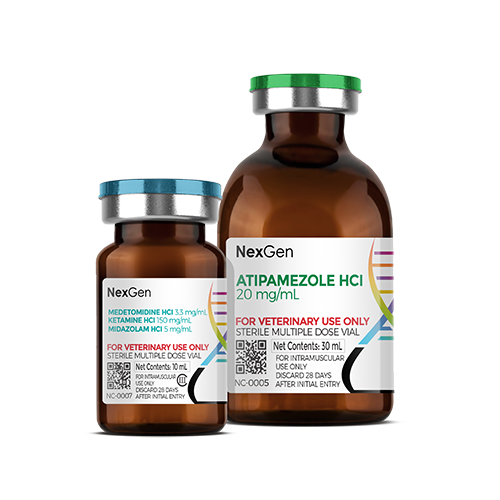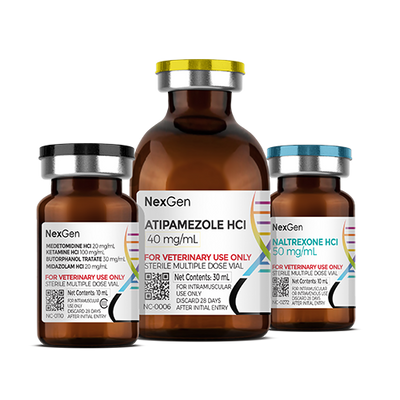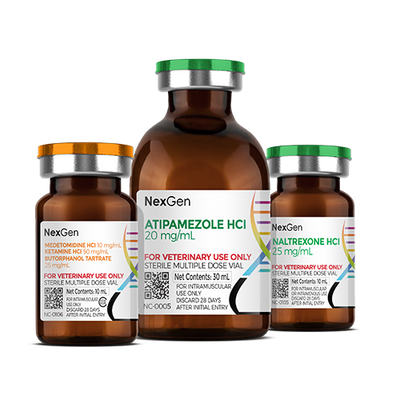
MKM™ Kit (Sedation & Reversal)
Login for pricing
- Brand
- Mixlab
- SKU:
- NC-0007K
- Product Type:
- Injectable
- Administration:
- Intramuscular
- Size:
- 10ml
- Controlled Substance:
- Schedule CIII
Many procedures that are routinely accomplished in domestic animals with minimal restraint require anesthesia for the welfare and safety of the zoo animal, as well as the veterinarian and support personnel. As such, the chemical immobilization of exotic animals in the zoo setting is a form of veterinary anesthesia conducted under substantially more difficult circumstances than in a practice setting.1 Although physiological responses during the maintenance of anesthesia are generally not different in a given species in the zoo (versus in the field), successful induction and recovery require significantly more knowledge and skills.2
Chemical Immobilization in the Zoo Setting
All reputable zoos will have a veterinarian on staff or on-call to serve its inhabitants, and these will generally be veterinarians who have dedicated themselves to treating wildlife in a zoo setting. Veterinarians and wildlife specialists who work in zoo settings often devise novel procedures for restraining animals prior to restraint and treatment, due to the unique construction of enclosures and other animal habitats within the zoo. And of course, different species will require different types of equipment and procedures depending upon their size and temperament.3
One of the circumstances in which chemical immobilization is employed in zoos is on those occasions where an animal escapes containment. Obviously, the best way to deal with an animal escape is to prevent it from occurring in the first place, and zoos are typically built and managed with this in mind. However, no matter how well enclosures are designed and procedures are adhered to, the possibility of an animal escape remains.4 In light of this, zoo managers typically enact comprehensive plans that detail procedures to guide the quick and safe recapture of escaped animals and protect zoo visitors and employees.
The MKM™ Kit
The MKM™ Kit by NexGen Pharmaceuticals, known as the “Escape Kit,” is specially-formulated for the immobilization of animals that have escaped from enclosures in a zoo setting. This drug combination is formulated for fast immobilization, taking into consideration the likely physiological parameters of animals under such conditions. It is also excellent for the immobilization of large carnivores (e.g., big cats) and primates, animals which can be unpredictable and potentially dangerous, even in a zoo setting. Thus, it is preferred for animals that have escaped containment, as well as for general/routine doctoring in zoos.
The MKM™ Kit contains:
-
Medetomidine 3.3 mg/ml
-
Ketamine 150 mg/ml
-
Midazolam 5 mg/ml
The MKM™ Kit also includes the reversal agent
-
Atipamezole 20mg/ml
Medetomidine (medetomidine hydrochloride), used alone and in combination with other drugs, has been shown to be useful for anesthesia and immobilization in zoo animals. Medetomidine is an α-2-adrenoreceptor agonist with sedative and analgesic properties. It is used by veterinarians as both a surgical anesthetic and analgesic. The pharmacological restraint and pain relief provided by medetomidine facilitates handling and aids in the conduct of diagnostic or therapeutic procedures. It also facilitates minor surgical procedures (with or without local anesthesia) and dental care where intubation is not required.5
Ketamine is a dissociative general anesthetic and an NMDA-receptor antagonist. It has been FDA-approved for use in humans, sub-human primates, and cats, although it has been used in many other species. It is used to induce general anesthesia in many species and as a constant rate infusion to provide analgesia and decrease the amount of inhalant used to maintain a surgical plane of anesthesia. It has been used intranasally in combination with midazolam in cats to induce sedation.2,5 Ketamine can inhibit NMDA receptors in the CNS and can decrease the wind-up pain effect. There is increasing interest in using it to prevent exaggerated pain associated with surgery or chronic pain states in animals.5
Midazolam is a benzodiazepine used primarily as a preoperative medication. In veterinary patients, midazolam is principally used for its sedative, anxiolytic, and muscle relaxant properties as a premedication prior to induction of general anesthesia. It exhibits similar pharmacologic actions as other benzodiazepines, with subcortical levels of the CNS being depressed, producing anxiolytic, sedative, skeletal muscle relaxant, and anticonvulsant effects. Postulated mechanisms of action include antagonism of serotonin, increased release of and/or facilitation of γ-aminobutyric acid (GABA) activity, and diminished release or turnover of acetylcholine in the CNS.5
Atipamezole is labeled by the U.S. Food and Drug Administration (FDA) for use as a reversal agent for medetomidine and dexmedetomidine in order to reduce their sedative and analgesic effects. Atipamezole is commonly used to treat horses and dogs, with extra-label use for other species. It is thought that this drug could be useful for reversal of other α-2 adrenergic agonists as well (eg, amitraz, xylazine, clonidine, tizanidine, brimonidine), but little information in this area is available at present.4,5
The combination of medetomidine, ketamine and midazolam in the MKM™ Kit has been shown to provide a safe, gentle induction and excellent recovery results.
Routes of Administration
The preferred route for the administration of an immobilizing drug by remote delivery is via intramuscular injection. The aim is to hit the animal in a specifically-selected site, causing injection into vascular tissue and facilitating rapid absorption of the drug. Not all areas of an animal's body are equally well-suited for injection by remote delivery; thus, the injection site should be carefully chosen.
The neck is generally a suitable site for large animals with muscular necks. Care should be taken to avoid hitting the jugular vein, the upper neck and the head. The ideal injection site is the trapezius muscle mass at the upper base of the neck. This injection site is suitable for species such as elk, moose, buffalo, bear, the equids and larger antelopes, rhinoceros, hippopotamus and elephant (if the ears can be avoided). Animals with slender necks, such as gazelle, gerenuk, giraffe and impala should not be darted in this area.
The shoulder is a suitable injection site in many larger species. This region is well-muscled, presenting a flat, perpendicular target. It is surrounded by relatively resilient areas and presents a fair-sized target in animals that are robust enough to be darted with remote delivery equipment.
To prevent the needle from becoming embedded in cartilage, the upper end of the scapula should be avoided. In sensitive species, the sight and smell of a dart in the shoulder may cause panic and flight. Some carnivores will destroy the dart by pulling it out with their teeth. The shoulder is not a suitable injection site for smaller species, due to their lesser size and limited muscle mass.
Where to buy the MKM™ Kit
The MKM™ Kit is available exclusively through NexGen Pharmaceuticals. It induces a smooth, reversible sedation for large wildlife species, and is recommended for exotic animals that have escaped containment in the zoo setting.
Please consult your veterinarian prior to beginning any treatment regimen.
FOR RX ONLY: A valid prescription from a licensed veterinarian is required for dispensing this medication.
1Nielsen L. Chemical immobilization of wild and exotic animals. Iowa: Iowa State University Press, 1999; 227-281.
2Lewis JCM. Anesthesia of non-domestic cats. Hall, L.W., Taylor, P.M. Anaesthesia of the Cat. London: Bailliere Tindall, 1994; 310-349.
3West, G., et. al. Zoo Animal and Wildlife Immobilization and Anesthesia, Second Edition. John Wiley & Sons, Inc., 2014.
4Arnemo, Jon & Kreeger, Terry. (2018). Handbook of Wildlife Chemical Immobilization, 5th Ed.
5Plumb’s Veterinary Drugs.




















